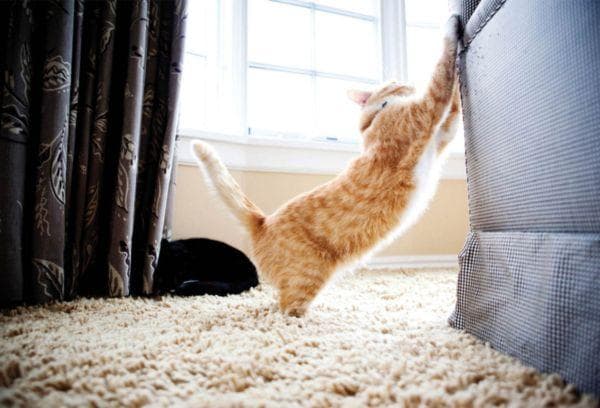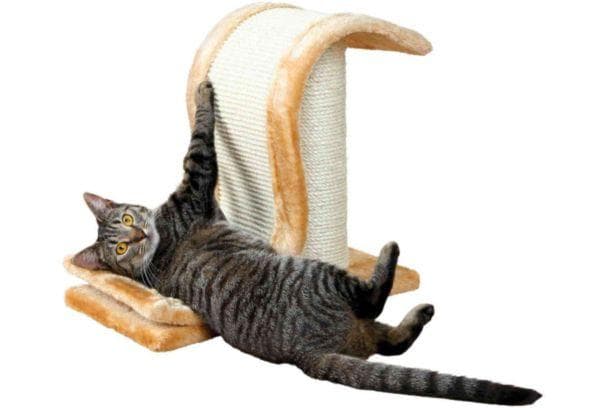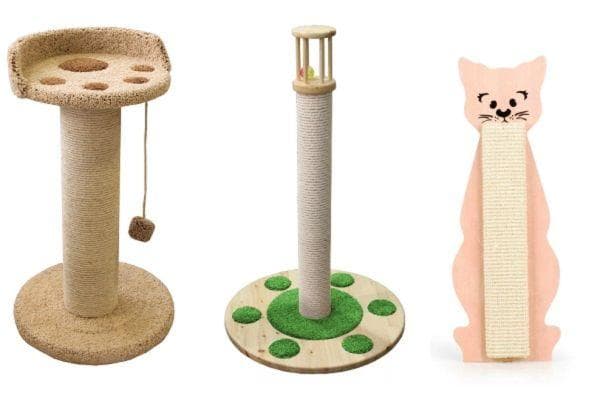How to make your cat scratch the claw pad and not the furniture
Domestic cats can severely scratch upholstery and damage wallpaper or wooden objects in the apartment. The animal’s behavior is explained by natural reasons, which will help you understand how to make the cat tear the claw clipper and not the furniture. All it takes is a little effort and patience, and even an adult pet can be trained to use a scratching post.

Why does a cat tear up furniture?
Pets raised from the first days of life easily accept the rules and requirements established by humans. But there are reasons why even an adult animal begins to tear up furniture. They are innate in nature and do not depend on breed or upbringing.
| Cause | Explanation |
| Paw warm-up
|
The stratum corneum of the claws is constantly renewed; the pet needs gymnastics or paw stretching to maintain physical shape. Outdoor animals use trees for these purposes. The pet has no choice but to stretch its paws on household items |
| Sharpening claws
|
Developing the innate hunting instinct. When a pet scratches a hard surface, the overgrown layer of claws peels off. A cat can chew its claws with its teeth, but it is much easier to sharpen them on the upholstery
|
| Stress relief
|
An animal can damage furniture not only with its teeth, but also with its claws. The behavior is typical for small kittens. If the habit persists, your pet will continue to scratch into adulthood. It relaxes, calms, improves the mood of cats
|
| Designating your territory
|
There are sweat glands on the paws that secrete a specific secretion. The pet marks the territory from the encroachments of competitors. The problem arises if there are several cats in the apartment
|
| Discomfort from long claws
|
The pet experiences pain from overgrown claws. The pads of the paws feel itchy and hangnails form. The animal begins to scratch objects and walls
|
How to keep a cat away from furniture
If an animal is used to scratching furniture, it will not be easy to wean it off. In some cases, owners are forced to replace the decoration of the room.
There are several effective methods worth trying.
- A sharp sound. Areas where the cat is used to sharpening its claws can be covered with rustling material, foil. A sharp noise will help when you try to sharpen your claws in a familiar place. To do this, just throw a bunch of keys or a baby rattle.
- Spraying with water. If the animal ignores sounds and continues to damage furniture, you can use a spray bottle. The method is very effective, since most cats cannot tolerate water.
- Sticky surface. The place where the pet is used to sharpening its claws can be covered with double-sided tape or self-adhesive paper. If it's furniture, it's worth making a barrier out of adhesive tape.
Veterinary pharmacies also sell repellent sprays. The composition contains substances whose odor is unpleasant to the animal. The product is used to treat areas of furniture familiar for sharpening claws.
Note! The smell of citrus fruits is very unpleasant for a cat's nose. You should spread out the zest, fabric sachets soaked in essential oil of lemon and orange. This is an affordable and effective remedy.
How to train a scratching post
You should arrange a place where the animal can sharpen its claws (preferably more than one).It is better to accustom to a scratching post from birth. It is more difficult for an adult pet to get used to this item; owners should be patient.
It will take several days for your cat to become familiar with the scratching post. To make the process go faster, you should periodically run your pet’s paw along the surface of the board, pressing lightly to release the claws. This way the animal will understand why it needs this item. If an animal is noticed sharpening its claws, it must be immediately taken to the appropriate place.
If your pet does something wrong, you should not hit or scold him - fear will cause a persistent hostility towards the nail clipper. For the slightest success, your pet should be praised and caressed, and rewarded with a treat. This way the cat will quickly understand what the person requires of it.
Frequently asked questions and answers
Which scratching post should you choose?
There are several types:
- Wall-mounted. A stationary scratching post in the form of a board attached to the wall. The front part is covered with jute rope and sisal. There are corner structures suitable for cats who like to crawl into the walls.
- Floor-standing. The flat model is fixed on a flat surface (floor), the pet scratches it like a carpet. Volumetric scratching posts are made in the form of stable columns with a wide base.
- Complex. This is a set of sharpening boards equipped with platforms, posts, rings, and soft elements.
You can purchase a scratching post separately or with a game complex included.
How to speed up nail training?
The pet often experiences the need to stretch and scratch immediately after sleep. Additionally, valerian and dried catnip will be attracted to the board. It is worth placing plant branches nearby.
How long will it take for a cat to stop scratching furniture?
Weaning off the habit of scratching upholstery and getting accustomed to a scratching post takes an average of 2-4 weeks.
Sharpening claws is a physiological need dictated by the anatomy and structure of the animal’s fingers. In nature, wild cats' claws wear down naturally. To grind down the claws of domestic cats, you need special items - scratching posts. Otherwise, pieces of furniture and decoration of the apartment will be used.



